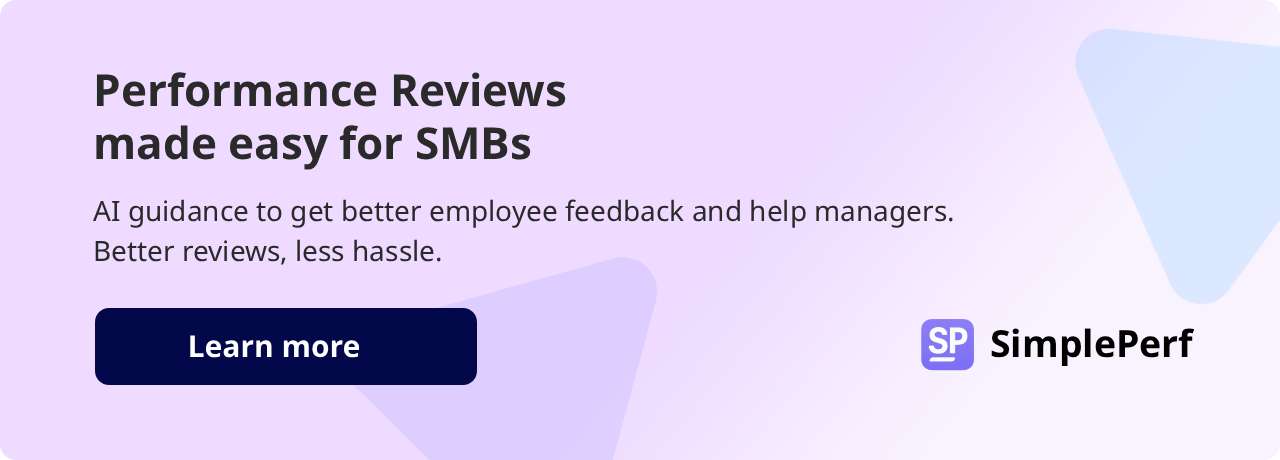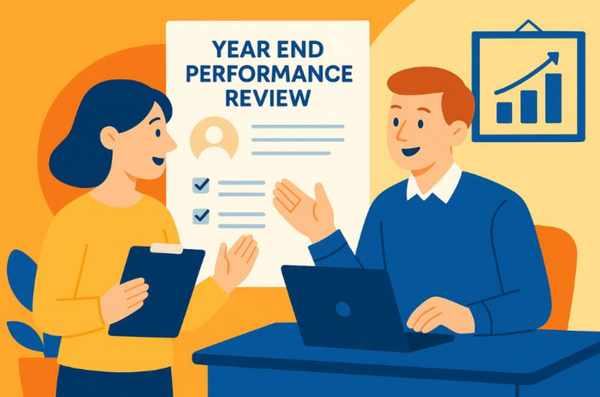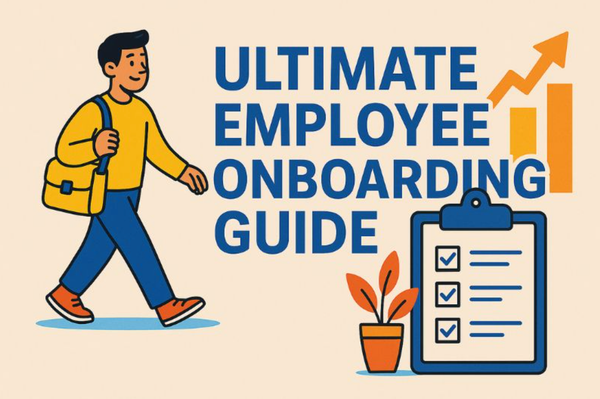3 Performance Review Examples To Inspire You
These examples are intended to inspire you to consider how you can conduct reviews like this and foster a positive team environment, which will lead us to the next section, ‘What Makes Performance Reviews Effective’.


Performance reviews have gotten a bad wrap - mainly because they’re awkward, confusing, and seem to take up too much time. But honestly, they don’t need to be like that, and when they’re done well, they encourage great conversations and real commitment to company goals, and personal development.
We think it’s time to get inspiration for what a performance review could look like. Write down five outcomes you’d like from running great reviews, and let’s see how we make it happen.
3 Performance review examples
In the following three examples, we will lay out what a review could look like. These examples are intended to inspire you to consider how you can conduct reviews like this and foster a positive team environment, which will lead us to the next section, ‘What Makes Performance Reviews Effective’.
We believe these two sections will help you achieve the outcomes you’re looking for.
Performance review 1: Will - The steady, high performer
Review transcript example
Will, today I’d like us to work through the work you’ve done this quarter, including your self-appraisal comments, and the peer feedback we’ve received. Feel free to jump in as we go along.
Let’s begin with your leadership on the recent engineering project. You received ten Clappy Kudos for your technical expertise. This is outstanding and shows how skilled you are. You’ve also been acknowledged in the 360 review for your clear communication during this project.
Data from Ticky Tracking on Slack has shown that you’re producing high-quality work on tight deadlines and keeping to the project costs. You’re showing outstanding potential for a project lead by doing this.
That said, you’ve struggled to provide constructive feedback to project engineers about their deliverables. This has caused confusion that could have been avoided. I suggest we discuss how you can give continuous feedback so all team members understand the goals they must reach.
SMART goals
Performance review summary
Will has demonstrated excellent leadership, communication, time management, and project management skills. He is well on his way to becoming a lead project manager. He will provide critical feedback to project engineers to help them meet their objectives. To show he can consistently demonstrate this skill, he will conduct four weekly meetings and provide a summary of the discussions. If he successfully demonstrates his competence over this period, there will be more leadership responsibilities given to him by the annual performance appraisal.
Performance review 2: Kate - Making use of new opportunities
Review transcript example
Kate, we’re meeting today to discuss your transition into app development this month and look at ways we can support your development. We’ll also be looking at feedback from our daily checks and peer recognition on Clappy Kudos.
First off, your work on the mobile UX has been super. Early feedback shows a 30% increase in user engagement. You’ve also been highly proactive in suggesting UI enhancements, which have saved the team hours of work according to the daily team meetings. Thank you for your commitment. I’d like to see you continue on this track.
On the flip side, the new challenges seem to have taken your focus off encouraging team spirit, which has previously been a strength you’ve displayed. In fact, the feedback from other team members indicates that this was a major reason for team success, and they feel at a loss without it.
Can we discuss how I can support you in this transition so that you don’t lose what you’re clearly very good at, while concentrating on new skills? I’m suggesting that you work with an online coach for 8 weeks who will help you retain your strengths through this transition.
SMART goals
Performance review summary
Kate has shown tremendous promise in her new role, already making a name for herself by increasing user engagement by 30%. While she is in this transition process, it is important that she does not lose previous wins and puts her strengths aside as an inspirational team member. I would like to see her succeed in her new role and go on to take a leadership role in the development team, just as she did before. We will review the situation in 8 weeks, after she works with a transition coach.

Performance review 3: Priya - Newbie with high potential
Review transcript example
Priya, welcome to your first performance appraisal. Let’s discuss your wins and see how we can offer you support going forward, since you are brand new to your role.
You only joined three weeks ago, but I see on Clappy Kudos that you’ve been making quite an impact with your colleagues for your positive attitude, innovative problem solving, and tenacity in helping customers solve difficult problems.
I received an email where one client wrote: ‘Priya is such a pleasure to deal with. I hope that she will be dedicated to our account permanently in the future.’
Ticky Tracking also showed that you handled 150% more support tickets than the team average. This is amazing work for a newcomer. I am very satisfied with your problem-solving skills. Priya, at the moment, you are progressing favourably according to the objectives we’ve set for you. There is one small issue - our daily check-ins on Slack are showing you are battling with customer escalations. Let’s get a senior staff member to sit with you for two weeks and coach you when these come up.
SMART goals
Performance review summary
Priya is brand new to our company. She has been with us for three weeks, and in this time, Priya has shown promise in her role as a customer service consultant. The feedback from peers and customers has been largely positive.
Priya is on track with her development and performance goals; however, an issue was identified with customer escalations, and we will provide her with the support she needs to confidently tackle this matter. She will do a series of 10 role plays over 2 weeks, and then I will reassess the situation. I fully expect her to improve in this area with the help of a mentor.
What makes performance reviews effective?
Having read the three performance review examples, it’s important to establish what parameters were used to deliver an effective review. Perhaps you picked up these elements in the examples we’ve provided?
1. Be specific: Give constructive feedback that anchors personal growth
The killer of trust, credibility, and relationship is vague feedback based on personal opinions and a lack of accurate data. If you want to change certain behaviors amongst your employees, you must give constructive criticism that is related to their job tasks, responsibilities, and objectives.
How to do this in practice:
Keep a feedback log throughout the review period to avoid recency bias. Tools like BuddiesHR can make this process much easier, especially if you're already using Slack for all your communication. Apps from BuddiesHR can help you track and keep data organically, without creating extra work for you. Not sure how this works? Let’s explain.
- Add Clappy Kudos to facilitate authentic, meaningful, and organic appreciation among employees. Clappy Kudos will help you collect tangible soft skills data, turning it into measurable and specific feedback. 📽️ Watch the demo.
- Add Stany Standup to automate daily Standups, check-ins, or any status updates. Not only will it free up hours of your time, but provide transparency of how your team is doing throughout the review period.
- Add Ticky Tracking to easily visualize project costs, profitability, and productivity of team members. Ticky will remind your team to log their project hours and costs, and you’ll have a clear view of project data that is specific and organically gathered in Slack.
This is showing just three ways that tools like BuddiesHR can make your performance reviews specific and measurable. What’s really valuable about these tools is that they gather data while gamifying the whole process. It takes the stress out of data collection for the whole team.
Examples of constructive feedback
Once you’ve gathered great data, you want to communicate it accurately. Here are some examples of how you can do this:
Instead of saying: ‘I think you did alright keeping our company values’.
Say: ‘You’ve received five Clappy Kudos for showing dignity and respect towards your team members this quarter. That is noteworthy, and I encourage you to keep demonstrating our company values like this.’
Instead of saying: ‘I don’t see you displaying a sense of urgency around project deadlines’
Say: ‘This quarter, the Ticky Tracking data shows you missed important project deadlines three times. This has cost the company $5,000 in lost revenue.’
Structure your feedback like this for clarity: Situation - Behavior - Impact
2. Give balanced feedback: Share wins and address gaps respectfully
Displaying good leadership skills can be hard, it is especially true when you have to give difficult feedback. Done incorrectly, it can have a devastating effect on self-esteem and team dynamics. But there’s hope.
How to do this in practice:
Start by setting the tone. ‘Today, we will be discussing both your wins and development areas over the last month. As I cover each point, please feel free to contribute towards the conversation if you have anything to add.’
Summarize all the points that will be discussed, and then circle back round to the positive feedback. Deal with each point, and provide specifics about the employee’s job performance. Next, ask for feedback on what has been discussed.
If you want to run effective performance reviews, you have to come prepared to deal with tough talks, emotions, defensiveness, and uncertainty about complex problems. Prepare yourself mentally for this, and you won’t be caught off guard.
At the end of the discussion, summarize and document actionable steps that will be taken by the employee to improve any gaps. Set a deadline for reviewing key milestones in this plan; this demonstrates your commitment to improvement. It will also help the employee value their professional growth.
3. Make it actionable: Clearly define goals and next steps
Every employee must walk away from the review knowing what success looks like in the next review cycle.
How to do this in practice:
Co-create S-M-A-R-T goals with your employee (specific, measurable, achievable, relevant, time-bound).
If you don’t already have one, consider using a performance management software that also offers AI-powered coaching. This will help you formulate actionable feedback by:
- Ensuring the goals are fair, specific, unbiased, and helpful.
- Providing you with the next steps for growth and improvement.
- Making it effortless for you to provide next steps for your employees - no more second-guessing what to write during the employee performance review.
Identify resources and support systems that will help the employee meet the SMART goals before the next review process.
4. Personalize: Value individuals, not just performance
Employee engagement creates a positive work environment where employees feel connected to the company values, the goals, their team, and their manager. Personal, honest feedback, with specific examples, goes a long way towards employee engagement. Achieving this is about acknowledging each person’s contribution.
How to do this in practice:
Refer to the personal goals and values the employee has mentioned. This shows that you have been paying attention to what’s important for them.
Instead of saying: ‘Good, the whole team has been working hard. Keep going’
Say: ‘I’ve seen you’re passionate about customer service from the great comments you’ve been getting from other departments, and how you’re encouraging others to provide better service. I would really like you to share how you do this in the next management meeting.’
Highlight distinct contributions made by your employee as follows: ‘Your calm approach towards that aggressive customer last week was really impressive. It settled the customer and other shoppers right down.’
Talk about career development in a way that resonates with the individual. Say: ‘I’ve watched you coach and guide new team members for a while now. I’d really like to recommend you for a team leader position. How do you feel about that?’
5. Wrap it up like a pro: Write a great performance review summary
One neglected aspect of annual performance reviews (or any other review, for that matter) is a summary of what was discussed. But a strong summary solidifies that entire process, providing a written record, thoughtful leadership, and clear actions for the next review.
Performance review summary examples
Example 1:
Sasha has been a forward-thinking and inspirational leader this quarter. She has taken full accountability for the client onboarding project and has received positive feedback from all stakeholders. We have identified that she can improve even further by learning to counsel members across cross-functional teams. We have picked a leadership course for her to attend. Sasha mentioned that she struggles to deal with conflict, and I agree. She will work with a personal coach for a period of four weeks to address this issue. We will review improvements during the next quarterly meeting.
Example 2:
This quarter, John has focused on developing a new app for our mobile offering. This has been a real challenge for him as he transitioned from his previous position. We have identified that communication skills are needed, as well as time management skills. To address this, he will work with an online coach for 8 weeks. John shows real potential. His work on the new app has been outstanding, and with the added soft skills, he is expected to do well. We will review in 10 weeks from today.
Conclusion
As our examples based on Will, Kate, and Priya show, performance reviews don’t have to be dull, rushed, confusing, or vague. With a structured approach and tools like BuddiesHR, which help you collect data, run your review process from Slack, and provide clear next steps, you can conduct truly meaningful reviews.
Bonus: If you have 10 users or less, BuddiesHR will give you the entire suite of Slack ‘buddies’ for free. You can test it to your heart’s content and prove that it will work for your performance review process.





